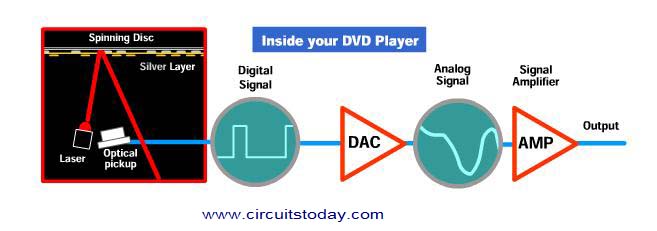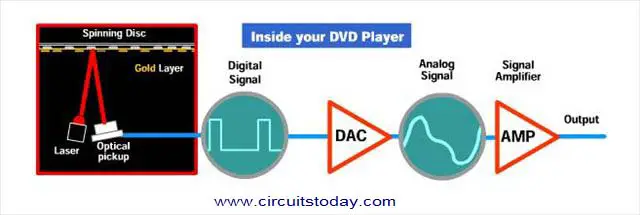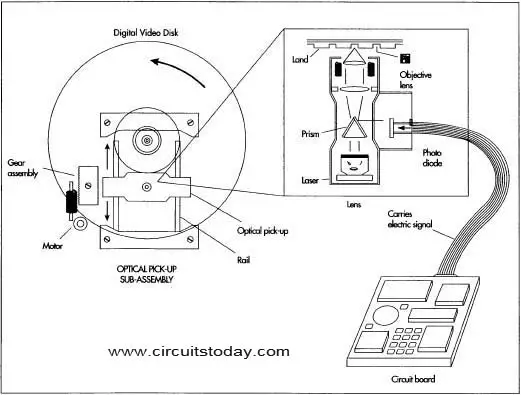Here we are going to look at how a DVD player works and the essential components for its working.
Parts of a DVD Player
The DVD player is not only used for playing the data present in a DVD, but also to write the content onto a DVD. To know this process it is essential to know the basics of a DVD.
As told earlier, DVD’s have pits and bumps in their track which holds the information that is required to be played. This information can be a video, audio or a mixture of both. When a DVD player reads this data, the smooth surface is usually taken as a ‘0’ and pits are usually taken as a ‘1’.
In order to create as well as read these data, a red laser with a wavelength of 600 nanometers. This is about 180 nanometers lesser than the wavelength of CD, which enables it to have a higher density of pits. Thus the size of the DVD increases. Though the first released DVD’s were only a single layer, 2 layered discs have been released nowadays. Single layer can hold only up to 4.7 GB of data while double layered DVD can hold up to 17 GB of data. The DVD design is similar to a CD a reflective silver layer in the centre and a semi-transparent gold layer on the top of it.
A DVD does not have the capacity to hold hi-def movies. So a MPEG-2 compression system is introduced. As this is used, the data will be encoded onto the DVD as elements of the changing frames. This has to be successfully decoded and decompressed by the DVD player.
Thus the parts of a DVD player are
1. Disc drive mechanism
The disc drive mechanism consists of a motor that will drive the disc in a circular motion. The mechanism will also have a disc feed – a loading tray that is used to accept the DVD from the user. Thus the entire disc drive is basically a spindle that holds the disc and a motor that is used to circle the disc. The spindle is held in its position with the help of small gears and belts that are attached internally. Some players have an automatic feed system in which, there will be no tray. Instead the disc will be automatically recognized after inserting a part of it.
2. Optical system
The optical system mainly consists of the laser beam, lenses, prism, photo-detectors and also mirrors. The output of this mechanism will be the input for the disc-drive. The laser beam will be a red laser diode which works at a wavelength of 600 nanometers. The optical system also requires a motor to drive it. The laser system and photo-detector is placed together on a single platform. The laser diode as well as other diodes is made with the help of glass.
3. Printed Circuit Board
The PCB is similar to that of any other electronic circuits. The electronic outline must be drawn on the PCB with the correct placement of all the IC’s resistors as well as capacitors. After the outline has been drawn, the components must be soldered to their respective places. All this must be done in a very clean environment so that the board does not become contaminated by dust. All the primary components of the electronic circuit should be made out of silicon.
Working of DVD Player
Take a look at the basic block diagram of how a DVD player works.


The pits and bumps in the DVD are hit by the laser from the optical mechanism of the DVD player. This laser will be reflected differently according to the change of pits and bumps. Though the laser hits a single spot, the DVD moves in a circular motion so that the entire area is covered. Mirrors are also used to change the spot.
These reflected laser beams are then collected by a light sensor (eg. photo-detector) which converts the different signals into a binary code. In short, the optical system helps in converting the data from the DVD into a digital code.
The binary signal is then sent to a Digital to Analog converter which will be setup in the PCB. Thus the corresponding analog signal of the DVD is obtained. The PCB also has amplifiers which amplify the signal and then sends it to the graphic and audio systems of the computer/TV. Thus, the corresponding audio/video signal is obtained. The basic working of a DVD player is shown below.

Assembling a DVD Player
As the different parts of the DVD player are all complicated electronic circuits, they are all manufactured by different people. They are later brought together and assembled at one place. During the assembling, the PCB will be connected to the rest of the machine and all the components are placed in the right positions. The whole package is then placed inside an outer plastic housing with a front panel with the buttons for various operations. This DVD player is then sent to a packaging station where they are placed safely inside boxes along with the respective power cords, operating manual, installing disks and so on. They are then taken by the distributors to various shops and then sold to customers.
Cautions while assembling a DVD Player
A DVD player will only be satisfactory to a customer only if it has a high performance. The degree of quality varies according to the flaws in the assembling process. Thorough inspections in both the visual as well as electrical divisions must be done most of the time. Flaws in the positioning of the different components can also cause the player to become faulty. After manufacturing the DVD also, the working performance is tested. To see the adverse effects of these players in different temperatures, the tests will be carried out in excessive heat as well as humidity. Since most of the parts of a DVD player is made by suppliers, they rely on other companies for good quality. The DVD assemblers will set a minimum standard for the supplies that they buy from outside. This specification must be met by them. The lenses and mirrors should be highly polished and cleaned before placing them.
An article regarding the detailed working of a DVD has been explained earlier.
TAKE A LOOK : WORKING OF DIGITAL VERSATILE DISC (DVD)

8 Comments
Thanks for this information Pls Mr. sir/ Miss Madam. As for me, am stil in my first year of 2yrs Dip in the study of Electrical and Electronics. I hav a plan to start my own Electronics Repair centre which will mainly deal with Consumer Electronics(CE). Therefore, I would realy like to learn more about Troubleshooting, and Repair of Consumer Electronics. I will realy appreciat whoever is willing to help me up. Thanks
Please is it possible to improvise and obtain the voltage of the different part of the disk drive mechanism using a USB? If so, how can it be done.
And can you also give more details on the working of the disc drive mechanism and optical reader mechanism? Much More detailed with schematic diagrams. Thank you. I love this article.
No the power requirement is 5 volts for logic and 12 volt for analog and 15 to 24 volts for the amplifier part. The power requirement will be around 20 to 25VA you cannot tap it from USB socket. Switched mode supply is used in the DVDs. The DVD contains switching power supply the optical driver, A/D converter and remote operation all in one board and power amplifier board separate, 4watts RMS per channel to 12 watts RMS per channel.
Greatings sir,
Is there any possible to assemble a dvd player with memory device………?
Subramaniam sir,i want to knw that wat is the use of flip flop .
i would like to know how a integrated circuit is being used in a mp3 player,and if the mp3 player is giving problem,what kind of problem can it be possibly be related with the integrated circuit,can you please tell me ways to check on the failure of the integrated circuit and ways to overcome the problem ?
your articles and circuit diagrams are highly informative and useful.may i request you to publish an article regarding “how a pen drive works and the circuit diagram for reading and writing in the pen drive.
Where is the hardware circuit?